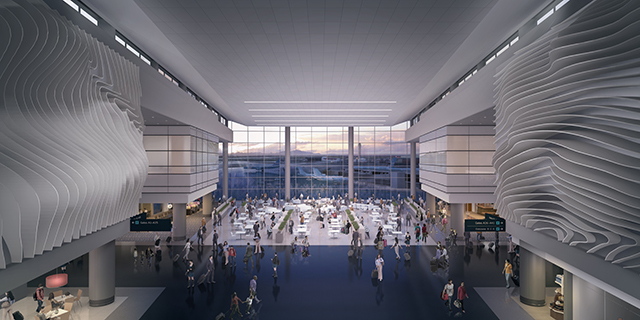by Brianna Crandall — November 16, 2015—Global design, architecture, engineering and planning firm HOK was selected to design the new Salt Lake City International Airport’s $1.8 billion terminal redevelopment. City and airport officials recently unveiled details of the project design, highlighting features that will make the terminal more “convenient, inspiring, and sustainable.”
Scheduled to open in 2020, the new three-story terminal and concourse will eventually replace a total of 29 outdated structures originally designed to accommodate half the number of the current passengers, including three separate terminals and five concourses. This single, highly efficient, 1.7 million-square-foot terminal building will be located west of the existing complex and serve up to 23 million passengers per year.

Floor-to-ceiling glass and earth-toned interior and exterior finishes provide an uplifting ambiance and connect passengers to the natural beauty of the local landscape, with expansive views of the airfield and iconic mountains.
By providing an uplifting travel experience for passengers, the flexible facility will support the region’s growth and the airport’s position as a hub for Delta Air Lines. The project team is also designing the terminal complex to mitigate seismic risk.
Nature-inspired design
HOK’s design celebrates Utah’s natural beauty and reputation as an outdoor recreation hub. The airport is nestled between the Wasatch and Oquirrh mountain ranges and the Great Salt Lake. Floor-to-ceiling glass provides expansive views to the airfield and iconic mountains, and provides an uplifting, cheerful ambiance, says HOK. Generous use of glass and earth-toned interior and exterior finishes connects passengers to the local landscape.
Robert Chicas, director of HOK’s Aviation + Transportation practice, noted:
One of the best things about coming into Salt Lake City is flying through the valley between the mountain ranges as you approach the airport. By bringing the beauty of the environment into the facility and incorporating sustainable design strategies that create a healthy, pleasant atmosphere, the terminal becomes an extension of that experience.
At the building’s heart is a soaring interior space called the Canyon, which houses security screening areas, shopping, and dining facilities. This open space is a visual anchor that organizes the terminal. A large-scale sculpture by award-winning artist Gordon Huether defines the Canyon walls and reflects natural Utah elements such as red rock canyons, alpine peaks, moving water, and cottony white clouds.

The soaring central interior space called the Canyon houses security screening areas, shopping, and dining facilities. A large-scale sculpture by artist Gordon Huether defines the Canyon walls and reflects natural Utah elements.
Separate from the baggage claim area, a large meet-and-greet space accommodates the groups that often welcome returning Latter-day Saints missionaries. A public art program highlights Salt Lake City’s thriving art community and lifts the spirits of passengers, says HOK.
Sustainable design
With a target of LEED Gold certification, sustainable design strategies minimize the airport’s environmental footprint. High-performance glazing systems are optimized to draw in daylight while preventing heat gain. Energy-efficient mechanical and lighting systems provide additional savings. The efficient configuration of the terminal and gate locations greatly reduces fuel use and aircraft emissions. Additionally, airlines plan to convert all of their airport ground equipment to electrically charged vehicles.
Airport officials expect the terminal, which is in its second year of construction, to open in 2020 and the entire project to be complete by 2023. In collaboration with the airport and airlines, the HOK team developed a construction phasing strategy that will incrementally add new facilities and decommission the old ones while minimizing disruption to the airport’s day-to-day operations. HOK’s “future-proof” design provides flexibility that will enable specific areas to be easily modified and reconfigured as the airport’s and airlines’ needs change over time.
See HOK’s Salt Lake City Airport Passenger Terminal case study page for more detailed information.
HOK’s Aviation + Transportation group designs high-performance passenger terminals, stations, intermodal facilities, automatic people mover systems, light rail systems, and other transportation amenities.




